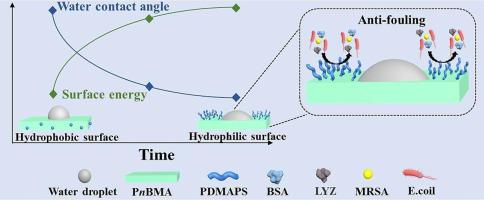Journal of Colloid and Interface Science ( IF 9.4 ) Pub Date : 2023-10-28 , DOI: 10.1016/j.jcis.2023.10.138 Jie Zhang 1 , Chen Wang 1 , Hanying Zhao 1

|
Latex polymer particles have been widely used in industry and everyday life. For decades the fabrication of “smart” latex film from latex particles has been a great challenge due to the difficulty in the synthesis of the functional latex particles by traditional emulsion polymerization using small molecular surfactants. In this manuscript, a simple and environmentally-friendly approach to the fabrication of “smart” latex films with dynamic surfaces is reported. Latex particles with poly(n-butyl methacrylate) (PnBMA) in the cores and zwitterionic poly-3-[dimethyl-[2-(2-methylprop-2-enoyloxy) ethyl]azaniumyl]propane-1-sulfonate (PDMAPS) in the shells are synthesized by reversible addition-fragmentation chain transfer (RAFT) mediated surfactant-free emulsion polymerization. The kinetics for the emulsion polymerization is studied, and the latex particles are analyzed by transmission electron microscopy (TEM), scanning electron microscopy (SEM) and dynamic light scattering (DLS). Latex films are prepared by casting aqueous solutions of the latex particles at temperatures above the glass transition temperature (Tg) of PnBMA. On the dried latex film, the hydrophobic PnBMA blocks occupy the top surface; after water treatment, the hydrophilic PDMAPS blocks migrate to the surface. A change in the surface hydrophilicity results in a change in the water contact angle of the latex film. A mechanism for the formation of the dynamic surface structure is proposed in this research. Antifouling applications of the latex films are investigated. Experimental results indicate that the water-treated latex film is able to efficiently inhibit protein adsorption and resist bacterial adhesion.
中文翻译:

乳胶膜的动态表面及其防污应用
乳胶聚合物颗粒已广泛应用于工业和日常生活中。几十年来,由于使用小分子表面活性剂的传统乳液聚合法难以合成功能性乳胶颗粒,用乳胶颗粒制造“智能”乳胶膜一直是一个巨大的挑战。在这份手稿中,报告了一种简单且环保的方法来制造具有动态表面的“智能”乳胶膜。核心为聚甲基丙烯酸正丁酯 (P n BMA) 和两性离子聚 3-[二甲基-[2-(2-甲基丙-2-烯酰氧基)乙基]氮杂铵基]丙烷-1-磺酸盐 (PDMAPS) 的乳胶颗粒)通过可逆加成断裂链转移(RAFT)介导的无表面活性剂乳液聚合合成。研究了乳液聚合的动力学,并通过透射电子显微镜(TEM)、扫描电子显微镜(SEM)和动态光散射(DLS)对乳胶颗粒进行了分析。通过在高于P n BMA 的玻璃化转变温度 (T g )的温度下浇铸乳胶颗粒的水溶液来制备乳胶膜。在干燥的乳胶膜上,疏水性的P n BMA嵌段占据顶面;水处理后,亲水性 PDMAPS 块迁移到表面。表面亲水性的变化导致乳胶膜的水接触角的变化。本研究提出了动态表面结构形成的机制。研究了乳胶膜的防污应用。实验结果表明,水处理乳胶膜能够有效抑制蛋白质吸附、抵抗细菌粘附。































 京公网安备 11010802027423号
京公网安备 11010802027423号